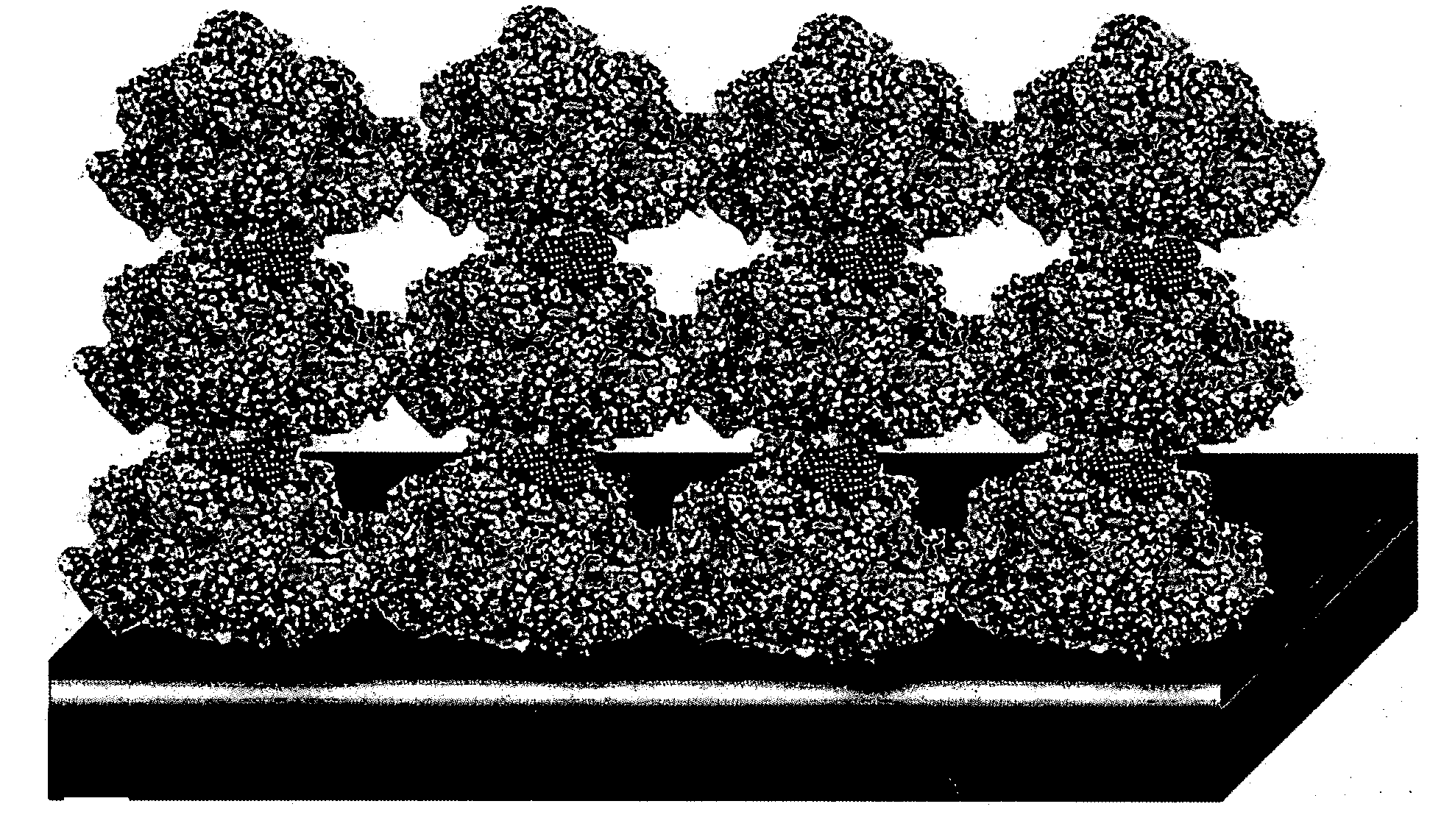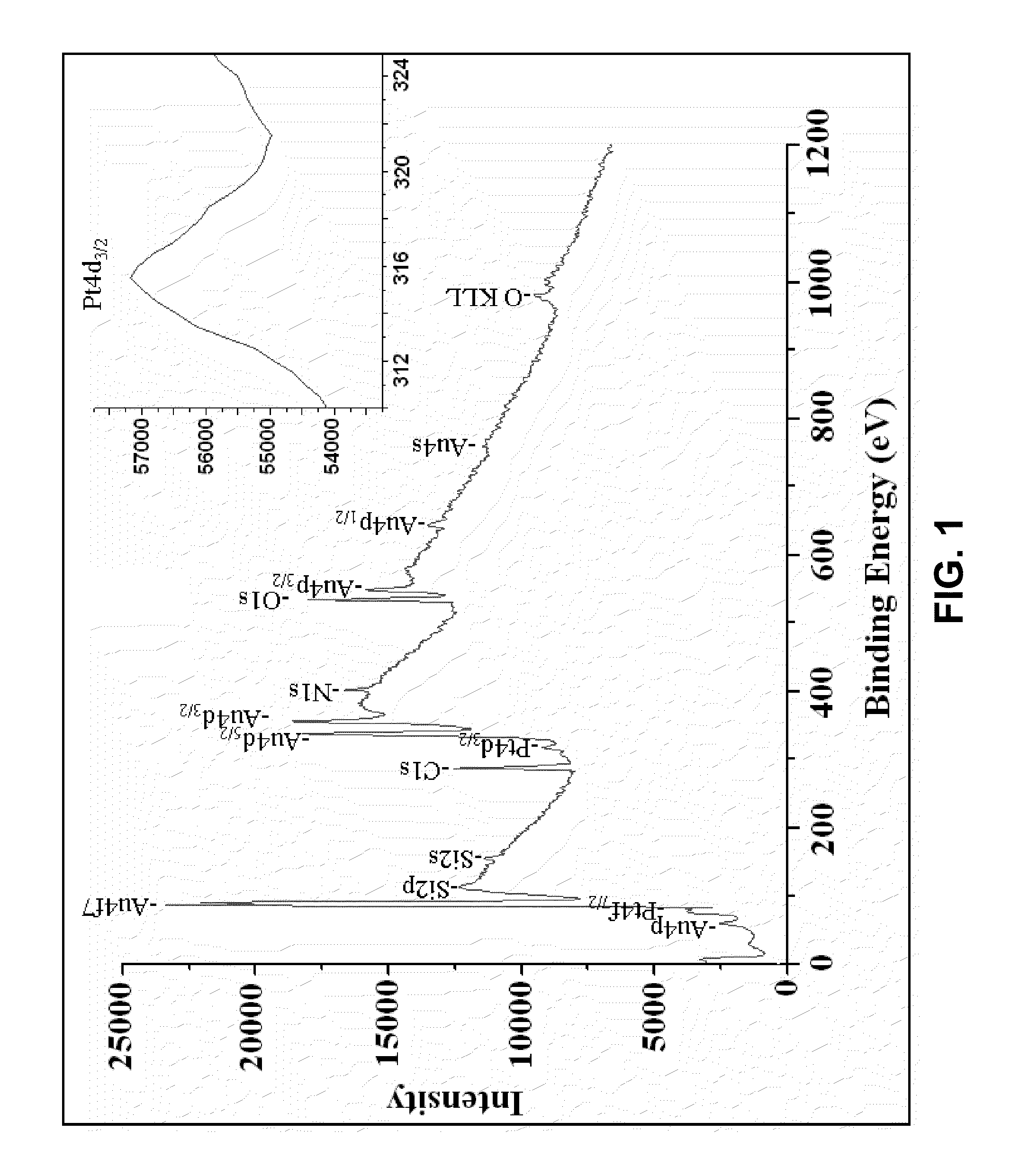Photoactive nanostructure and method of manufacturing same
a technology of photoactive nanostructure and manufacturing method, which is applied in the direction of immunoglobulins, peptide sources, peptides, etc., can solve the problems of increasing processing difficulty
- Summary
- Abstract
- Description
- Claims
- Application Information
AI Technical Summary
Benefits of technology
Problems solved by technology
Method used
Image
Examples
example 1
Fabrication of Oriented Multilayers of Photosystem I Proteins on Solid Surfaces by Auto-Metallization
[0229]Materials and Methods
[0230]Site-directed mutagenesis: For site-directed mutagenesis in the psaB gene from Synechocystis sp. PCC 6803 was induced by homologous recombination using plasmids pZBL for induction of cysteine Y634C mutations and pBLΔB for psaB interruption in recipient cells, as previously described [L. Frolov, Y. Rosenwaks, C. Carmeli, I. Carmeli, Adv. Mater. 2005, 17, 2434; M. T. Zeng, X. M. Gong, M. C. Evans, N. Nelson, C. Carmeli, Biochim. Biophys. Acta 2002, 1556, 254; X. M. Gong, R. Agalarov, K. Brettel, C. Carmeli, J. Biol. Chem. 2003, 278, 19141].
[0231]Isolation and characterization of PS I complexes: PS I was isolated from thylakoid membranes by solubiliztion with n-dodecyl β-D-maltoside and purification on DEAE-cellulose columns and on a sucrose gradient. The isolation of PS I, the analysis chlorophyll content and photochemical activity determined by flash-i...
example 2
A Hybrid Nanostructure Composed of a Photo-Synthetic System and Metal Nanoparticles: Plasmon Enhancement Effect
[0246]Materials and Methods
[0247]Fabrication of NP / PSI hybrids: Hybrid metal NP PS I were fabricated by direct covalent binding between NP and PSI. Cysteine mutants at the oxidizing end of PS I were bound to the metal NP by formation of sulfide bond between the cysteine thiols and the metal. NPs were fabricated by reduction of 1 mM solution of AuCl3 and AgNO3 by BH4 in the presence of 5 nM PSI.
[0248]Model of Hybrid Photosystem: The present embodiment incorporates a photosystem I (PS I) reaction center and a single metal NP (FIG. 9). The PS I reaction center from cyanobacteria (Synechocystis sp. PCC6803) is conjugated with a metal NP through a biolinker. The PS I reaction center is composed of the following elements / cofactors: a chlorophyll dimer (special pair, P), two pairs of chlorophylls (eC-B2 / eC-A3 and eC-A2 / eC-B3), two quinone molecules (QA(B)), and the iron-sulfur cen...
example 3
Supporting Data for Hybrid Metal Nano Particles Ps I
[0262]As shown in Example 2, the efficiency of chemical energy production PS I is strongly enhanced in the presence of metal nanoparticles (NP). In the case of photo-transport experiments with the photosynthetic reaction centers, the plasmon resonance generated in the NP enhances the chlorophyll's absorption and increases the photocurrent response in PS I. The type of metal used and the size of the NP can be tuned to generate plasmon with energy that can efficiently enhance the absorption by PS I. For example, the present inventors calculated that gold or silver coated silicon nanoparticles of 21 nm in diameter will generate plasmon resonance frequency that enhance the absorption of light by PS I at peak absorption at about 700 nm. Plasmons are tuned to the energy that overlaps the absorption of PSI to efficiently enhance absorption at the two absorption maxima of PS I. The present inventors also calculated that light energy can en...
PUM
| Property | Measurement | Unit |
|---|---|---|
| diameter | aaaaa | aaaaa |
| diameter | aaaaa | aaaaa |
| quantum efficiency | aaaaa | aaaaa |
Abstract
Description
Claims
Application Information
 Login to View More
Login to View More - R&D
- Intellectual Property
- Life Sciences
- Materials
- Tech Scout
- Unparalleled Data Quality
- Higher Quality Content
- 60% Fewer Hallucinations
Browse by: Latest US Patents, China's latest patents, Technical Efficacy Thesaurus, Application Domain, Technology Topic, Popular Technical Reports.
© 2025 PatSnap. All rights reserved.Legal|Privacy policy|Modern Slavery Act Transparency Statement|Sitemap|About US| Contact US: help@patsnap.com



